Prashanth Dental Clinic(Vijayanagar)
Procare Dental Clinic(Nagarabhavi)
Talk to us
+91-080-23352628
+91-080-23214995
+91-080-23352628
+91-080-23214995

ORTHODONTICS (Dental Braces)
Orthodontics (Dental Braces)
Orthodontics is a specialist branch of dentistry concerning the development and management of irregularities and abnormalities of the teeth and jaws. Its aim is to produce a healthy, functioning bite, creating higher resistance to disease processes and improving your personal appearance. This contributes to both your mental and physical well being.
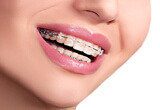 Orthodontic treatment usually involves wearing a brace (appliance). This puts gentle pressure on specific teeth to move them into the right place.
Orthodontic treatment usually involves wearing a brace (appliance). This puts gentle pressure on specific teeth to move them into the right place.
Orthodontic treatment uses appliances to correct the position of the teeth.
The four main types are :
- FIXED BRACES
- REMOVABLE BRACE
- FUNCTIONAL APPLIANCES
- RETAINERS
FIXED BRACES :
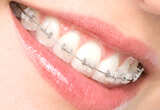 Fixed orthodontic appliances are the most commonly used appliances for orthodontic treatment in use today. As the name suggests they are bonded to the teeth and are not removable by the patients.
Fixed orthodontic appliances are the most commonly used appliances for orthodontic treatment in use today. As the name suggests they are bonded to the teeth and are not removable by the patients.
The brackets have in built features to control the labio-lingual, mesio-distal inclination of the teeth. These in-built features are known as the prescription of the bracket. The prescription of the bracket is expressed when a rectangular orthodontic archwire is placed through the slots of the brackets on the teeth.
Discovering The Different Types of Fixed Braces
If you’re considering braces for yourself or your child, you have many options. Your orthodontist will help you make the best choice for your scenario, but here are the basics of each type.
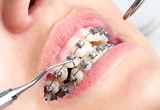 Metal braces : Often also called “traditional braces,” metal braces have two basic components. These are the metal bracket that is applied to the teeth and the bendable metal wire that is threaded through the brackets in order to apply pressure to the teeth and ultimately move them. Traditional metal braces are made of high quality stainless steel or titanium. With metal braces, you have the option of adding colored elastics (rubber bands) for a more unique and colorful smile.
Metal braces : Often also called “traditional braces,” metal braces have two basic components. These are the metal bracket that is applied to the teeth and the bendable metal wire that is threaded through the brackets in order to apply pressure to the teeth and ultimately move them. Traditional metal braces are made of high quality stainless steel or titanium. With metal braces, you have the option of adding colored elastics (rubber bands) for a more unique and colorful smile.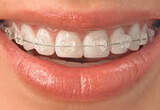 Ceramic braces : are made of clear materials and are therefore less visible on your teeth than metal braces. For this reason, ceramic braces are used mainly on older teenagers and adult patients who have cosmetic concerns. While they are visually less prominent, they do require more attention to oral hygiene as ceramic braces are larger and are more brittle than their metal counterparts.
Ceramic braces : are made of clear materials and are therefore less visible on your teeth than metal braces. For this reason, ceramic braces are used mainly on older teenagers and adult patients who have cosmetic concerns. While they are visually less prominent, they do require more attention to oral hygiene as ceramic braces are larger and are more brittle than their metal counterparts.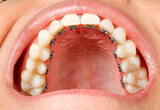 Lingual braces : are one of the "invisible" treatment options that your orthodontist may have to offer.For the most part, they look like conventional dental braces that have been mounted on the backside (reverse, lingual, tongue side) of your teeth. This hides them from view, making them difficult to see by others.
Lingual braces : are one of the "invisible" treatment options that your orthodontist may have to offer.For the most part, they look like conventional dental braces that have been mounted on the backside (reverse, lingual, tongue side) of your teeth. This hides them from view, making them difficult to see by others.
They can be very difficult to keep clean, as the wearer cannot see the braces, nor is he used to cleaning the area that he now has to clean extensively. They can also make it difficult to talk. Lingual braces are also not a good option for those that have severe orthodontic conditions that need extensive treatment. And because they take longer and are often more expensive than traditional braces.
Removable Braces
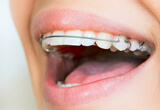 Simple treatment may be carried out with a removable appliance (a plate that can be taken out to be cleaned). Removable braces have delicate wires and springs attached, which move the teeth using gentle pressure. They may be used to correct an early problem, but because they can only carry out simple tooth movements, they cannot manage complex treatment. Removable braces need to be worn all the time except for cleaning or sport.
Simple treatment may be carried out with a removable appliance (a plate that can be taken out to be cleaned). Removable braces have delicate wires and springs attached, which move the teeth using gentle pressure. They may be used to correct an early problem, but because they can only carry out simple tooth movements, they cannot manage complex treatment. Removable braces need to be worn all the time except for cleaning or sport.Functional Appliances
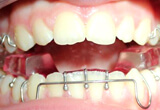 These are removable appliances which use the muscles of the face and jaws to improve the way that the teeth bite together. Functional appliances tend to work most effectively in growing patients so are not used in adult patients. Although the braces are removable, they usually need to be worn throughout the day and in bed each night in order to work effectively. Most functional appliance treatment patients then progress onto fixed appliance orthodontic treatment to fully correct their orthodontic problem.
These are removable appliances which use the muscles of the face and jaws to improve the way that the teeth bite together. Functional appliances tend to work most effectively in growing patients so are not used in adult patients. Although the braces are removable, they usually need to be worn throughout the day and in bed each night in order to work effectively. Most functional appliance treatment patients then progress onto fixed appliance orthodontic treatment to fully correct their orthodontic problem.Orthodontic Headgear
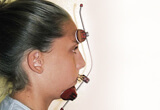 Orthodontic headgear is a type of orthodontic appliance attached to the patient's head with a neck strap or a number of straps around the head. The device typically transfers the force to the teeth via a facebow or J hooks to the patients dental braces or a palatal expander that aids in correcting more severe bite problems or is used in retention of the teeth and jaws of the patient. Orthodontic headgear is the general name for an appliance, worn partly outside the mouth, which creates just enough force to move the teeth properly and guide the growth of the face and jaws.
Orthodontic headgear is a type of orthodontic appliance attached to the patient's head with a neck strap or a number of straps around the head. The device typically transfers the force to the teeth via a facebow or J hooks to the patients dental braces or a palatal expander that aids in correcting more severe bite problems or is used in retention of the teeth and jaws of the patient. Orthodontic headgear is the general name for an appliance, worn partly outside the mouth, which creates just enough force to move the teeth properly and guide the growth of the face and jaws.
There are several different types of orthodontic headgear, each designed to work best in a specific situation. We will design a treatment program to address your individual needs, and select the most appropriate type of headgear
Clear Aligners
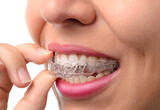 Clear Aligners or Invisalign is a revolutionary treatment product for misaligned teeth meant to make teeth straightening convenient, safe and comfortable. Unlike braces, Invisalign aligners are virtually invisible, made of soft comfortable medical grade polymer material. Patients can easily wear and take off these aligner trays depending on the situation, event or activity. For today’s busy teens and adults alike, Invisalign offers the ultimate flexibility, convenience and desired results.
Clear Aligners or Invisalign is a revolutionary treatment product for misaligned teeth meant to make teeth straightening convenient, safe and comfortable. Unlike braces, Invisalign aligners are virtually invisible, made of soft comfortable medical grade polymer material. Patients can easily wear and take off these aligner trays depending on the situation, event or activity. For today’s busy teens and adults alike, Invisalign offers the ultimate flexibility, convenience and desired results.
Your clear aligners are custom-made for you. The aligners are virtually invisible and fit snugly over your teeth. Each aligner shifts your teeth slightly, moving them horizontally and vertically and even rotating them when needed. Your aligners are engineered to use the right amount of force in the right place at the right time. When you change to the next set of aligners (typically every week) your teeth gradually move into position, following a custom treatment plan mapped out by your doctor. Removable aligners so you can enjoy all the foods and activities you love, and brush and floss easily. No injuries due to broken wires or brackets.
Interceptive Treatments
Some children can benefit from early treatment, generally around the age of 8 or 9 years. To establish if your child is a candidate for this type of treatment, we recommend a visit to the orthodontist from the age of 7 years. The objective of this type of treatment is to avoid the development of more important problems and to facilitate or shorten a later treatment phase during adolescence. Here are some examples of situations where such a treatment is indicated:
- Early loss or abnormal persistence of milk teeth.
- Protrusive upper incisors.
- Lower incisors are placed in front of the upper incisors.
- Upper dental arch narrower than the lower arch.
- Deviation of the chin when closing the mouth.
- Thumb sucking after the age of 5 years.
Self-Ligating Braces
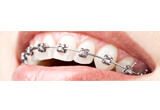 Self-ligating braces look very similar to the traditional fixed braces that orthodontists have used to straighten teeth for decades. However, they are now available with clear or ceramic brackets, making them far more discreet.
Self-ligating braces look very similar to the traditional fixed braces that orthodontists have used to straighten teeth for decades. However, they are now available with clear or ceramic brackets, making them far more discreet.
They also use clips instead of elastic bands to hold the brace’s wire in place. This creates less friction and makes it easier for you to brush around your brace and keep your teeth clean during your orthodontic treatment. They can also achieve precise results by giving your clinician complete control over the way our teeth move.
Retainers
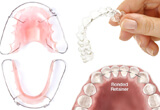 Retainers are used near the end of a course of orthodontic treatment. They hold straightened teeth in place while the surrounding gum and bone adjusts to their new position, and can either be removable or fixed. It’s likely there will be some tooth movement if you stop wearing your retainer. Changes in the position of your teeth can continue throughout life and are part of the normal ageing process. The only way to have permanently straight teeth is to wear a retainer on a part-time basis for life.
Retainers are used near the end of a course of orthodontic treatment. They hold straightened teeth in place while the surrounding gum and bone adjusts to their new position, and can either be removable or fixed. It’s likely there will be some tooth movement if you stop wearing your retainer. Changes in the position of your teeth can continue throughout life and are part of the normal ageing process. The only way to have permanently straight teeth is to wear a retainer on a part-time basis for life.
It takes time for the bone and all the tissues around your teeth to reorganize and therefore it is necessary to use retainers until your bite stabilizes. In the first month after the braces are removed, the risk of relapse is very high. Relapse means that the teeth can take up to one year or more to stabilize after treatment. If you had gaps between your teeth before treatment, the retention period will be longer. Usually, retainers are worn for as long a time as you have had your braces. If your teeth move back to their original positions, you may need fixed braces again to correct them.
Care and Maintenance of Braces
- Frequency of Cleaning
If you wear braces it is important to clean them after every meal. Food particles are more easily trapped in the mechanisms of dental braces and can then fall through and become lodged between the teeth. Care and maintenance of your braces will add extra time to your at home dental care regime, but it is imperative that the task is carried out at least twice a day, however, we recommend cleaning after every meal. - Flossing and Brushing for Dental Braces
Brushing should begin with a soft orthodontic toothbrush. You should then use the proxabrush to brush between the braces and teeth. Orthodontists also recommend the use of a fluoride mouthwash that will help rinse away any extra debris that is left in the mouth after brushing, and will help prevent cavities. - Cleaning of Retainers
If you wear a retainer it is important that this is cleaned whenever you clean your teeth. Brush the retainer clear of food at least twice per day. Also soak the retainer in a denture cleaning solution at least once per week. - Foods to Avoid
The wires used in braces are not too fragile but eating hard foods such as toffees, apples or nuts, should be avoided. Hard foods can bend or break the wires, and a dental visit will need to be scheduled in order adjust the braces. Also avoid sugary snacks as this will only increase the risk of tooth decay. - Broken or Loose Braces
Over time, brackets and wires may become loose; if this does happen you may be able to resolve the problem yourself. Your orthodontist should have provided you with orthodontic wax, and this can be used to slip brackets and wires back into place. If rubber bands become loose, or wires are broken, then a visit to the orthodontist will be needed to either adjust or replace these.
Test Data
Test Data

About
Dr. Prashanth Kumar
Dr. Prashanth Kumar
Dr. Prashanth Kumar's vision to fulfill the need for specialized dental care and treatment resulted in the establishment of Prashanth Dental Clinic in 1999.
He graduated from Government Dental College, Bangalore in 1999. Completed his Diplomat in Orthodontics from ICNOG university, Italy. He is also a fellow in Implant and Esthetic Dentistry. He is an active Member of the International Orthodontic Association and Indian Dental Association. He is also an authorized dental surgeon to KPCL and BHEL.
He graduated from Government Dental College, Bangalore in 1999. Completed his Diplomat in Orthodontics from ICNOG university, Italy. He is also a fellow in Implant and Esthetic Dentistry. He is an active Member of the International Orthodontic Association and Indian Dental Association. He is also an authorized dental surgeon to KPCL and BHEL.
About
Dr. Soujanya Prashanth
Dr. Soujanya Prashanth
Dr. SOUJANYA PRASHANTH graduated from SDM, Dharwad in 2002. She is an active Member of the Indian Dental Association. She is a consultant dental surgeon to BGS GLOBAL HOSPITAL, Kengeri, Bangalore. She is also an authorized dental surgeon to BEL and BHEL.
She started her practice from the year 2004 and with that came the establishment of Procare Dental Clinic , she has evolved the clinic from the basic requirement to advanced facilities to each and every patient.
She started her practice from the year 2004 and with that came the establishment of Procare Dental Clinic , she has evolved the clinic from the basic requirement to advanced facilities to each and every patient.
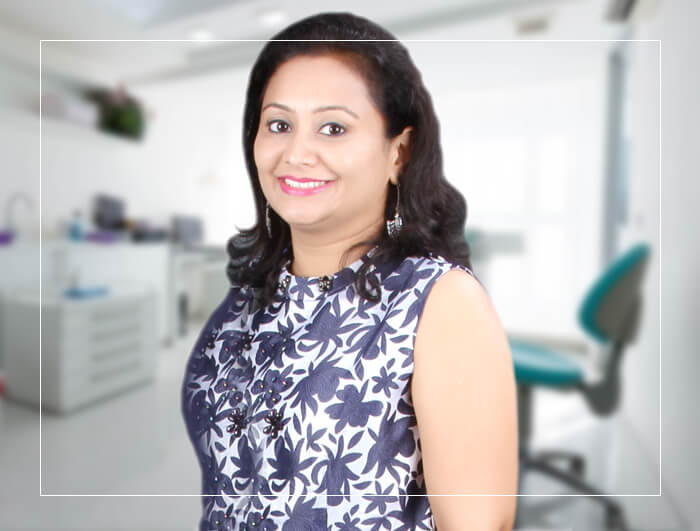
Need a Doctor for Check - up ?
Just Make An Appointment
Just Make An Appointment
Get in touch
Prashanth Dental Clinic

#175, 15th Main, M.C. Layout,
Opposite Vijayanagar Metro
Station ( Gate A)
Vijayanagar, Bangalore-560040
Opposite Vijayanagar Metro
Station ( Gate A)
Vijayanagar, Bangalore-560040
Procare Dental Clinic

#3, Jnanabharathi Main Road, Nagarabhavi,
Bangalore-560072
Bangalore-560072
Copyright © All Rights reserved | Privacy Policy



